You are using an out of date browser. It may not display this or other websites correctly.
You should upgrade or use an alternative browser.
You should upgrade or use an alternative browser.
RMS Titanic: Theories, Exploration & Madness!
- Thread starter MrRING
- Start date
Analogue Boy
Bar 6
- Joined
- Aug 10, 2005
- Messages
- 13,600
I’m not sure what the implication of this is. This would obviously correlate to the plight of the lower classes travelling on the lower decks on such a big ship in a disaster.Graphic analyses of Titanic survival chances.
View attachment 47996
View attachment 47995
SOURCE:
Apparently, this picture is atypical for maritime disasters despite the long-term persistence of the 'women and children first' trope.
One could wish that the crew were given a separare analysis here—and, indeed, that the two graphs were combined.
- Joined
- Oct 29, 2002
- Messages
- 36,487
- Location
- East of Suez
I’m not sure what the implication of this is. This would obviously correlate to the plight of the lower classes travelling on the lower decks on such a big ship in a disaster.
Yes, but that correlation is broken by other factors.
A young girl in third-class, for instance, has comparable or perhaps better odds of survival than an adult male in first-class—despite implied location.
Tigerhawk
Godzilla Just Has Anger Management Issues....
- Joined
- Jan 20, 2016
- Messages
- 3,959
- Location
- Skaro
Hi everyone,
This just arrived in my inbox; never heard of the guy who has sent it to me but I thought I would pass it on to you all for your reading pleasure...
----------------------------------------------------------------------------------
I have come to a terrifying conclusion; THERE ARE PEOPLE STILL ALIVE TRAPPED ABOARD THE TITANIC!!!
Consider, if you will, the undeniable evidence:
1) Video taken by submersibles that have visited the wreck show that that The Titanic has not broken up but is in one piece; this means that the ship is water-tight.
2) Any survivors of the tragedy would have no doubt used their Edwardian ingenuity and constructed an air filtration device to allow the circulation of breathable air throughout the ship.
3) When The Titanic sank there were 7,000 people aboard; if only a handful of them survived the catastrophe there would be enough food and water on board the ship to last them for generations!
4) This is possibly the most disturbing evidence; there is fully documented accounts of ships receiving a bizarre SOS message when crossing the Atlantic sea at the point were The Titanic sank. Everytime, the message is the same; “We are the survivors of RMS Titanic, trapped aboard the ship on the ocean bed-if anybody can here us, for God's sake help us”!!!
Right now, there are people trapped on The Titanic who have been born aboard the ship, and have never seen the light of day and know nothing of the outside world!!
I believe that we have a moral duty to help these poor souls and I am raising funds to attempt a rescue mission; anyone wishing to discuss this with me should contact me via this Newsgroup.
Ian LaSalle
[email protected]
- Joined
- Oct 29, 2002
- Messages
- 36,487
- Location
- East of Suez
This is well worth your time:
Accompanying podcast and explanations here:
https://snr.org.uk/the-mariners-mirror-podcast/the-titanic/
Accompanying podcast and explanations here:
https://snr.org.uk/the-mariners-mirror-podcast/the-titanic/
Cochise
Priest of the cult of the Dog with the Broken Paw
- Joined
- Jun 17, 2011
- Messages
- 8,478
The key factor in the sinking, as far as I can tell from the evidence, was actually the last minute attempt to avoid the iceberg. Had they hit it head on, then the ship may well have survived as fewer of the waterproof partitions would have been compromised.Wkipedia cites sources suggesting that there were 20 large bergs measuring up to 200 feet high (61 metres) and numerous smaller bergs. The actual iceberg was identified, with a mark on it consistent with the paint having scraped off the Titanic's hull.
The ship was doing around 21 kts (24 mph, or 39 kmh) which is pretty fast. The iceberg was spotted at 11:40 pm ship's time, so late at night. I suspect complacency and a poor lookout were bigger factors than any fancy meteorological explanation.
This is apparently a photo of the actual iceberg.
View attachment 37522
There is a lot of twaddle talked about the reckless speed of the ship, trying to capture the Blue Riband etc. In fact she was not fast enough to do that, and she was never intended to - White Star had decided to compete on luxury rather than speed (you only need to pay for the luxury once, when building the ship - you pay for the speed in fuel consumption on every crossing).
It was a very clear night and no doubt all concerned expected they would be able to see any obstacle in time.
Last edited:
DrPaulLee
Justified & Ancient
- Joined
- Aug 7, 2002
- Messages
- 2,031
It's the time of year when I run my annual Titanic recreation on Twitter. My account is "open" so anyone can view it: or you can view it as a feed on my website. The URLs are www.twitter.com/drplee and www.paullee.com/tot

Last edited:
What Tyler
Spoon, Jar, Jar, Spoon...
- Joined
- Dec 5, 2021
- Messages
- 261
Exactly. The Lusitania and Mauretania were faster and designed to challenge and win the Blue Riband; I think they could reach at least, and cruise at, 24 plus knots due to their turbine engines, and were classed at least initially by the Royal Navy as “ auxiliary cruisers”...whereas the Olympic class had main reciprocating engines and a low pressure turbine, giving a cruising speed of 21-22knots.The key factor in the sinking, as far as I can tell from the evidence, was actually the last minute attempt to avoid the iceberg. Had they hit it head on, then the ship may well have survived as fewer of the waterproof partitions would have been compromised.
There is a lot of twaddle talked about the reckless speed of the ship, trying to capture the Blue Riband etc. In fact she was not fast enough to do that, and she was never intended to - White Star had decided to compete on luxury rather than speed (you only need to pay for the luxury once, when building the ship - you pay for the speed in fuel consumption on every crossing).
It was a very clear night and no doubt all concerned expected they would be able to see any obstacle in time.
DrPaulLee
Justified & Ancient
- Joined
- Aug 7, 2002
- Messages
- 2,031
People just get confused by stuff.
The Titanic was traveling at 22.5 knots at the time of the collision and this was with 5 boilers, or 15 furnaces unlit. We know she could do faster. To make up for lost time on her delivery trip she made 23.25 knots. And, probably again to make up time, she radioed that she made 23 knots en route to Queenstown.
At 11.40pm on April 14th the Titanic was so far ahead of the Olympics comparable location at the same point on her maiden voyage that it was almost assured that she would get in late on April 16th. For her to arrive as planned early on the 17th, the Titanic would have to slow down considerably, and there's no proof of that. Judging by the recollections of survivors, the ship was speeding up and the increase in vibrations from the engines was noticeable.
There was just one fly in the ointment. Fog. Ships were reporting their own progress being hampered by a large fog bank that lay between the Titanic and New York. It's debatable how much this would have delayed the Titanic's arrival.
The Titanic was traveling at 22.5 knots at the time of the collision and this was with 5 boilers, or 15 furnaces unlit. We know she could do faster. To make up for lost time on her delivery trip she made 23.25 knots. And, probably again to make up time, she radioed that she made 23 knots en route to Queenstown.
At 11.40pm on April 14th the Titanic was so far ahead of the Olympics comparable location at the same point on her maiden voyage that it was almost assured that she would get in late on April 16th. For her to arrive as planned early on the 17th, the Titanic would have to slow down considerably, and there's no proof of that. Judging by the recollections of survivors, the ship was speeding up and the increase in vibrations from the engines was noticeable.
There was just one fly in the ointment. Fog. Ships were reporting their own progress being hampered by a large fog bank that lay between the Titanic and New York. It's debatable how much this would have delayed the Titanic's arrival.
RaM
Justified & Ancient
- Joined
- Mar 12, 2015
- Messages
- 3,807
- Location
- NW UK
It was a very still night a flat calm rare in the Atlantic, this made the spotting of ice burgers harder as
they tended to blend into the darkness, if there's any kind of swell the waves braking
on the burg make it show up better.

they tended to blend into the darkness, if there's any kind of swell the waves braking
on the burg make it show up better.

ramonmercado
CyberPunk
- Joined
- Aug 19, 2003
- Messages
- 58,319
- Location
- Eblana
SS Mesaba found.
The ship which sent an iceberg warning to the Titanic before the ocean-liner sank has been found in the Irish Sea.
The merchant vessel SS Mesaba was crossing the Atlantic in April 1912 and sent a wireless message to the Titanic but its warning never reached the bridge. The supposedly unsinkable ship then hit an iceberg and sank on her maiden voyage, with the loss of 1,500 lives.
Mesaba herself was sunk, by a torpedo in World War I in 1918.
https://www.bbc.com/news/uk-wales-63039737
The ship which sent an iceberg warning to the Titanic before the ocean-liner sank has been found in the Irish Sea.
The merchant vessel SS Mesaba was crossing the Atlantic in April 1912 and sent a wireless message to the Titanic but its warning never reached the bridge. The supposedly unsinkable ship then hit an iceberg and sank on her maiden voyage, with the loss of 1,500 lives.
Mesaba herself was sunk, by a torpedo in World War I in 1918.
- Lost lives of the Welsh Titanic victims
- Life after surviving the Titanic
- Titanic: The myth of the unsinkable ship
https://www.bbc.com/news/uk-wales-63039737
ramonmercado
CyberPunk
- Joined
- Aug 19, 2003
- Messages
- 58,319
- Location
- Eblana
Losing a finger likely saved two lives.
One hundred and eleven years ago a man lost a finger, an accident that would ultimately save his life.
Joe Swarbrick was still in his teens when he and his brother made plans to emigrate. Leaving the Shore Road in Belfast, they found work on a transatlantic cruise liner as engine crew. But before it set off across the Atlantic Joe lost his index finger and he left the ship at Southampton. That ship was Titanic. More than 1,500 people died when the Belfast-built ship sank on its maiden voyage in April 1912 after hitting an iceberg.
Joe and his older brother Bill wanted to go to Canada when they found jobs on the world's most luxurious liner, joining it as it left Belfast.
Joe's daughter Elinor Farquhar now 85, says her dad was involved in a work-related incident during the ship's delivery to Southampton.
"It meant he had to get off at Southampton and attend the hospital and his brother was asked to accompany him," Elinor told BBC News NI. "My dad was told by the hospital that he couldn't travel on to America and had to go back home to Belfast and Bill was told to go with him. Both of them were very disappointed and my dad felt guilty about holding his brother back."
However by the time the men were back in Belfast a few days later disaster had hit Titanic. ...
Had the brothers been on the boat they almost certainly would have died. Both men worked in the engine room - Bill as a greaser and Joe as a trimmer. They were part of the crew who worked in the engine room, covered in soot and coal dust. Had Joe stayed on Titanic his chance of survival would have been slim - out of the 79 trimmers on board, just over 20 survived. ...
Joe went on to serve in the Navy in both world wars and was awarded on OBE in 1937 for his services with the Belfast Steamship Company.
He died aged 52 after suffering complications due to injuries received in World War Two.
https://www.bbc.com/news/uk-northern-ireland-65262939
One hundred and eleven years ago a man lost a finger, an accident that would ultimately save his life.
Joe Swarbrick was still in his teens when he and his brother made plans to emigrate. Leaving the Shore Road in Belfast, they found work on a transatlantic cruise liner as engine crew. But before it set off across the Atlantic Joe lost his index finger and he left the ship at Southampton. That ship was Titanic. More than 1,500 people died when the Belfast-built ship sank on its maiden voyage in April 1912 after hitting an iceberg.
Joe and his older brother Bill wanted to go to Canada when they found jobs on the world's most luxurious liner, joining it as it left Belfast.
Joe's daughter Elinor Farquhar now 85, says her dad was involved in a work-related incident during the ship's delivery to Southampton.
"It meant he had to get off at Southampton and attend the hospital and his brother was asked to accompany him," Elinor told BBC News NI. "My dad was told by the hospital that he couldn't travel on to America and had to go back home to Belfast and Bill was told to go with him. Both of them were very disappointed and my dad felt guilty about holding his brother back."
However by the time the men were back in Belfast a few days later disaster had hit Titanic. ...
Had the brothers been on the boat they almost certainly would have died. Both men worked in the engine room - Bill as a greaser and Joe as a trimmer. They were part of the crew who worked in the engine room, covered in soot and coal dust. Had Joe stayed on Titanic his chance of survival would have been slim - out of the 79 trimmers on board, just over 20 survived. ...
Joe went on to serve in the Navy in both world wars and was awarded on OBE in 1937 for his services with the Belfast Steamship Company.
He died aged 52 after suffering complications due to injuries received in World War Two.
https://www.bbc.com/news/uk-northern-ireland-65262939
RaM
Justified & Ancient
- Joined
- Mar 12, 2015
- Messages
- 3,807
- Location
- NW UK
This is supposed to be Titanic leaving Belfast Loch,
if so what is the equipment hanging from the right, starboard bow?
There was a iceberg detector called the Fessenden’s oscillator but
that was supposedly not available till the following year that was a
early form of sonar, and a system called passive sonar that was intended
to pick up sound from a remote source but this was intended to
help finding a buoy or harbour mouth in poor visibility. but
that does not really fit the kit hanging off the bow.
if so what is the equipment hanging from the right, starboard bow?
There was a iceberg detector called the Fessenden’s oscillator but
that was supposedly not available till the following year that was a
early form of sonar, and a system called passive sonar that was intended
to pick up sound from a remote source but this was intended to
help finding a buoy or harbour mouth in poor visibility. but
that does not really fit the kit hanging off the bow.
Erinaceus
Justified & Ancient
- Joined
- Jul 22, 2020
- Messages
- 1,317
- Location
- Hythe, Kent
You can just make out "Titanic", forward of the cable, about 1:33 in the video. I searched for 'Titanic leaving Belfast Lough' on Youtube and someone commented that it must have been filmed before completion because the funnels appear to be a solid colour and not the yellow and black she had when she sailed.
I've no idea what is hanging over the side.
I've no idea what is hanging over the side.
Salmonellus
Devoted Cultist
- Joined
- Oct 23, 2020
- Messages
- 230
Those are toilets for the workers.
I think you're right, PaulLee. If you look at the whole video it's pretty clear that those pipes descend from a small hut sort of arrangement that wasn't there on the finished Titanic.
The hut and pipes are in the traditional spot for a ship's 'heads' or toilets.
https://en.wikipedia.org/wiki/Head_(watercraft)
The first time I visited an old sailing vessel and looked at the heads, my reaction was "That's silly. Why place the heads in the bows? You'll be sailing into whatever you drop over the side."
Then the penny dropped. A wind-powered vessel is, by definition, moving with the wind coming from behind it. Even at the bow the overall movement of the air will be from stern to bow. So placing the heads forward will mean that anything dropped from there will tend to move away from the ship. It's only powered ships that have the air flow moving the other way.
Hence the traditional placement of the 'heads'.
Floyd
Antediluvian
- Joined
- Apr 2, 2019
- Messages
- 7,946
Titanic: First ever full-sized scans reveal wreck as never seen before
The world's most famous shipwreck has been revealed as never seen before.
The first full-sized digital scan of the Titanic, which lies 3,800m (12,500ft) down in the Atlantic, has been created using deep-sea mapping.
It provides a unique 3D view of the entire ship, enabling it to be seen as if the water has been drained away.
The hope is that this will shed new light on exactly what happened to the liner, which sank in 1912.
More than 1,500 people died when the ship struck an iceberg on its maiden voyage from Southampton to New York.
"There are still questions, basic questions, that need to be answered about the ship," Parks Stephenson, a Titanic analyst, told BBC News.
He said the model was "one of the first major steps to driving the Titanic story towards evidence-based research - and not speculation."
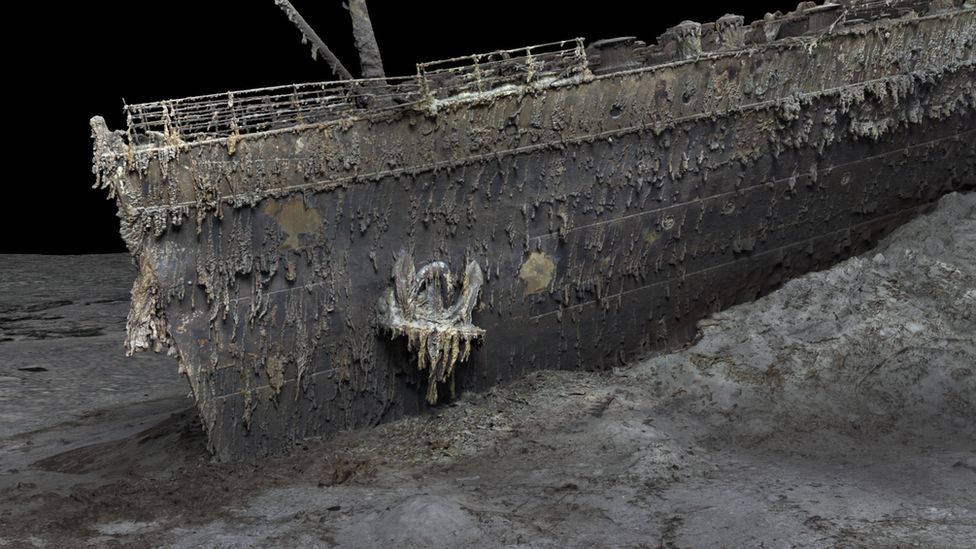
The bow of the Titanic is still instantly recognisable even after so long underwater
The Titanic has been extensively explored since the wreck was discovered in 1985. But it's so huge that in the gloom of the deep, cameras can only ever show us tantalizing snapshots of the decaying ship - never the whole thing.
The new scan captures the wreck in its entirety, revealing a complete view of the Titanic. It lies in two parts, with the bow and the stern separated by about 800m (2,600ft). A huge debris field surrounds the broken vessel.
The scan was carried out in summer 2022 by Magellan Ltd, a deep-sea mapping company, and Atlantic Productions, who are making a documentary about the project.
Submersibles, remotely controlled by a team on board a specialist ship, spent more than 200 hours surveying the length and breadth of the wreck.
They took more than 700,000 images from every angle, creating an exact 3D reconstruction.
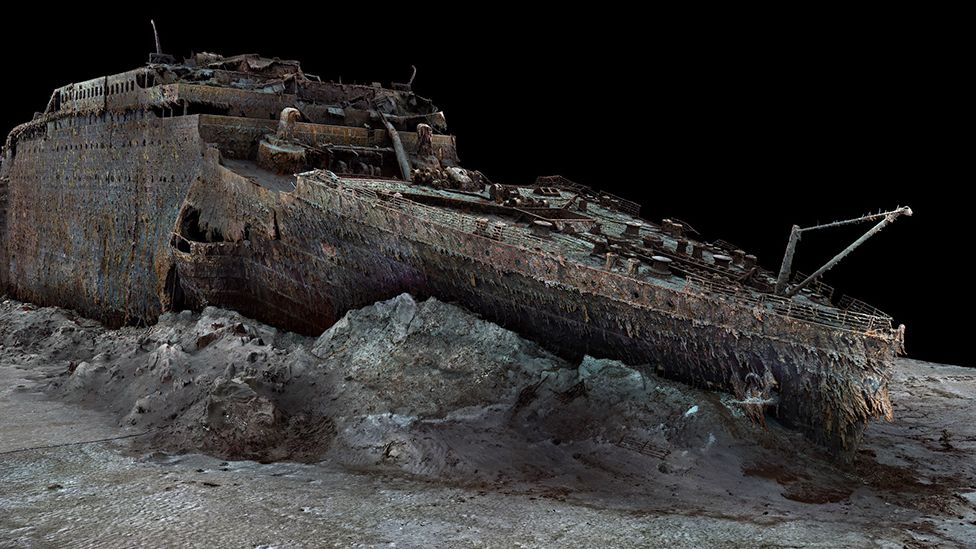
The scan is made up from 700,000 images captured by submersibles
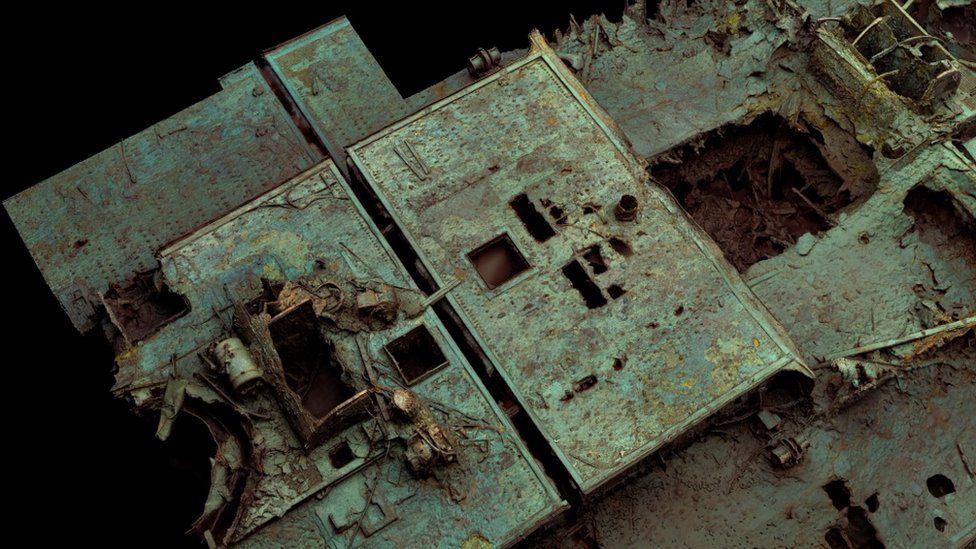
The large hole to the right of the boat deck opens over where the grand staircase once stood
Magellan's Gerhard Seiffert, who led the planning for the expedition, said it was the largest underwater scanning project he'd ever undertaken.
"The depth of it, almost 4,000m, represents a challenge, and you have currents at the site, too - and we're not allowed to touch anything so as not to damage the wreck," he explained.
"And the other challenge is that you have to map every square centimetre - even uninteresting parts, like on the debris field you have to map mud, but you need this to fill in between all these interesting objects."
The scan shows both the scale of the ship, as well as some minute details, such as the serial number on one of the propellers.
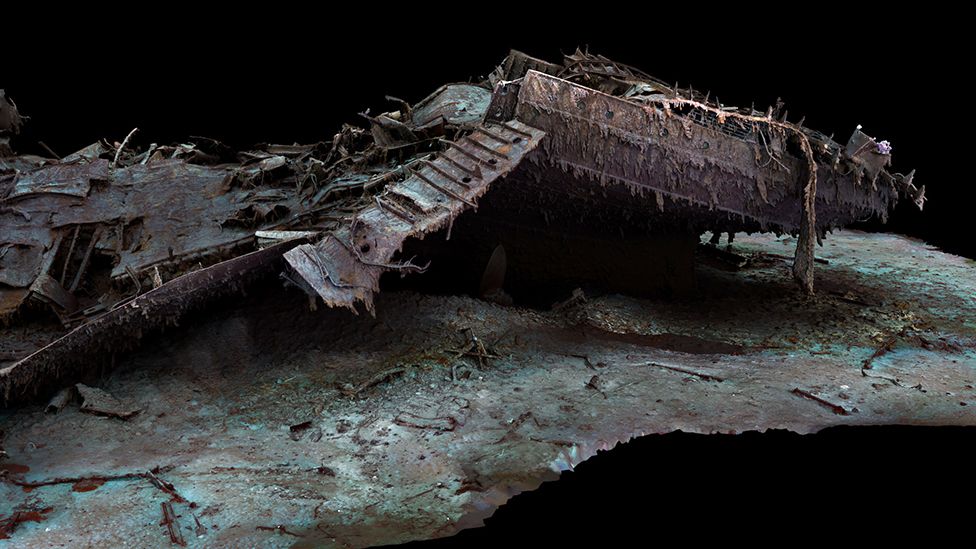
The stern, which has separated from the bow, is a chaotic tangle of steel
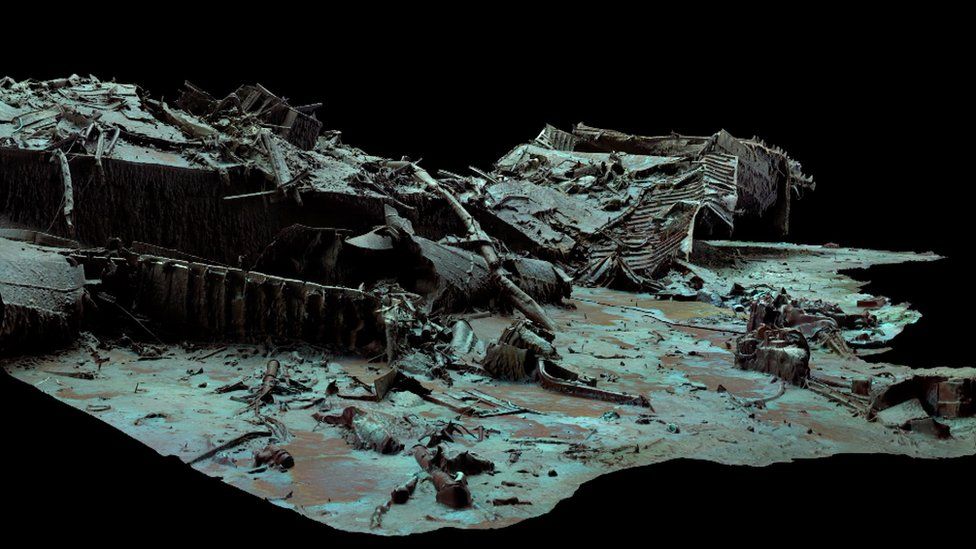
The stern corkscrewed into the seabed as it plunged into the depths
The bow, now covered in stalactites of rust, is still instantly recognisable even 100 years after the ship was lost. Sitting on top is the boat deck, where a gaping hole provides a glimpse into a void where the grand staircase once stood.
The stern though, is a chaotic mess of metal. This part of the ship collapsed as it corkscrewed into the sea floor.
In the surrounding debris field, items are scattered, including ornate metalwork from the ship, statues and unopened champagne bottles. There are also personal possessions, including dozens of shoes resting on the sediment.
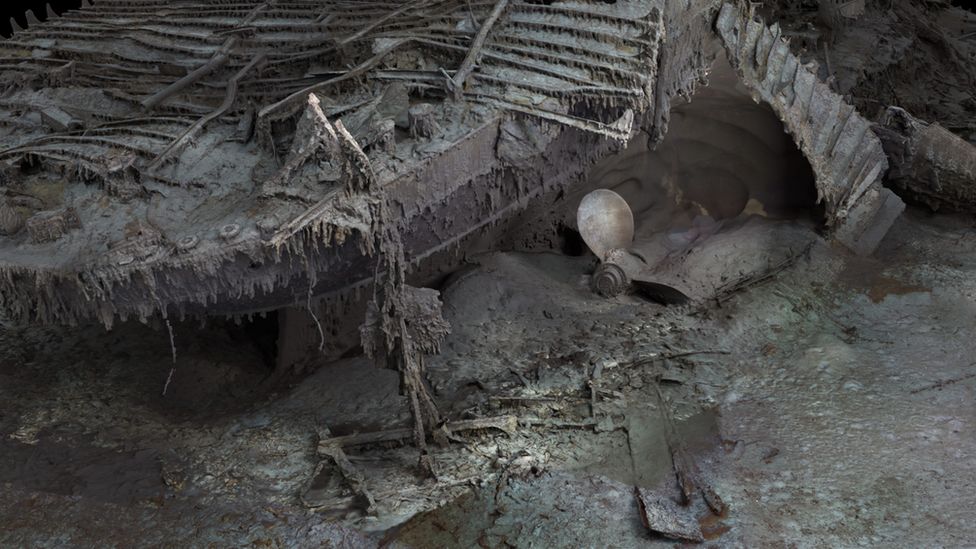
Extraordinary detail can be seen of the ship
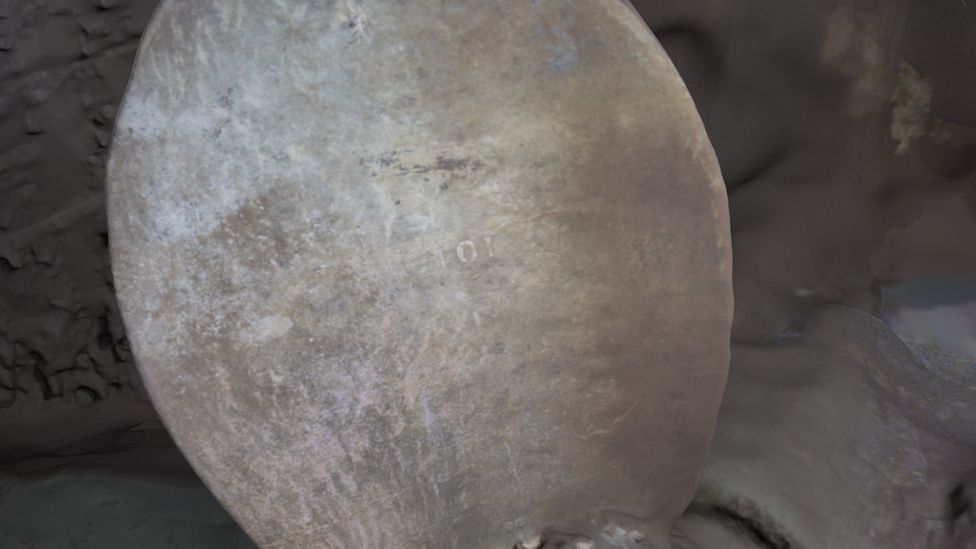
The serial number on a propeller can be made out
Parks Stephenson, who has studied the Titanic for many years, said he was "blown away" when he first saw the scans.
"It allows you to see the wreck as you can never see it from a submersible, and you can see the wreck in its entirety, you can see it in context and perspective. And what it's showing you now is the true state of the wreck."
He said that studying the scans could offer new insight into what happened to the Titanic on that fateful night of 1912.
"We really don't understand the character of the collision with the iceberg. We don't even know if she hit it along the starboard side, as is shown in all the movies - she might have grounded on the iceberg," he explained.
Studying the stern, he added, could reveal the mechanics of how the ship struck the sea floor.
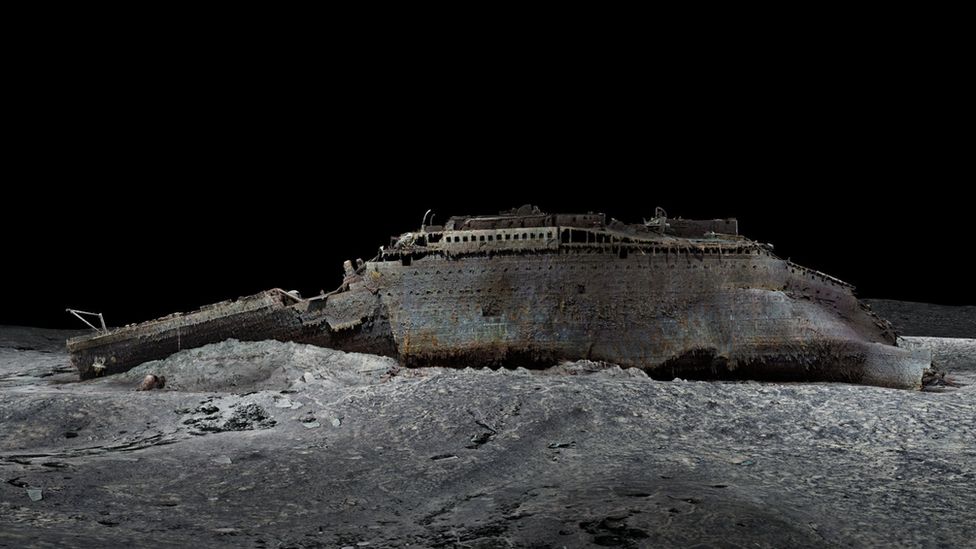
The hope is that the scan could reveal more about what happened on the night the Titanic was lost
The sea is taking its toll on the wreck, microbes are eating away at it and parts are disintegrating. Historians are well aware that time is running out to fully understand the maritime disaster.
But the scan now freezes the wreck in time, and will allow experts to pore over every tiny detail. The hope is the Titanic may yet give up its secrets.
https://www.bbc.co.uk/news/science-environment-65602182
Lord Lucan
Justified & Ancient
- Joined
- Feb 17, 2017
- Messages
- 4,639
Titanic: First ever full-sized scans reveal wreck as never seen before
The world's most famous shipwreck has been revealed as never seen before.
The first full-sized digital scan of the Titanic, which lies 3,800m (12,500ft) down in the Atlantic, has been created using deep-sea mapping.
It provides a unique 3D view of the entire ship, enabling it to be seen as if the water has been drained away.
The hope is that this will shed new light on exactly what happened to the liner, which sank in 1912.
More than 1,500 people died when the ship struck an iceberg on its maiden voyage from Southampton to New York.
"There are still questions, basic questions, that need to be answered about the ship," Parks Stephenson, a Titanic analyst, told BBC News.
He said the model was "one of the first major steps to driving the Titanic story towards evidence-based research - and not speculation."

The bow of the Titanic is still instantly recognisable even after so long underwater
The Titanic has been extensively explored since the wreck was discovered in 1985. But it's so huge that in the gloom of the deep, cameras can only ever show us tantalizing snapshots of the decaying ship - never the whole thing.
The new scan captures the wreck in its entirety, revealing a complete view of the Titanic. It lies in two parts, with the bow and the stern separated by about 800m (2,600ft). A huge debris field surrounds the broken vessel.
The scan was carried out in summer 2022 by Magellan Ltd, a deep-sea mapping company, and Atlantic Productions, who are making a documentary about the project.
Submersibles, remotely controlled by a team on board a specialist ship, spent more than 200 hours surveying the length and breadth of the wreck.
They took more than 700,000 images from every angle, creating an exact 3D reconstruction.

The scan is made up from 700,000 images captured by submersibles

The large hole to the right of the boat deck opens over where the grand staircase once stood
Magellan's Gerhard Seiffert, who led the planning for the expedition, said it was the largest underwater scanning project he'd ever undertaken.
"The depth of it, almost 4,000m, represents a challenge, and you have currents at the site, too - and we're not allowed to touch anything so as not to damage the wreck," he explained.
"And the other challenge is that you have to map every square centimetre - even uninteresting parts, like on the debris field you have to map mud, but you need this to fill in between all these interesting objects."
The scan shows both the scale of the ship, as well as some minute details, such as the serial number on one of the propellers.

The stern, which has separated from the bow, is a chaotic tangle of steel

The stern corkscrewed into the seabed as it plunged into the depths
The bow, now covered in stalactites of rust, is still instantly recognisable even 100 years after the ship was lost. Sitting on top is the boat deck, where a gaping hole provides a glimpse into a void where the grand staircase once stood.
The stern though, is a chaotic mess of metal. This part of the ship collapsed as it corkscrewed into the sea floor.
In the surrounding debris field, items are scattered, including ornate metalwork from the ship, statues and unopened champagne bottles. There are also personal possessions, including dozens of shoes resting on the sediment.

Extraordinary detail can be seen of the ship

The serial number on a propeller can be made out
Parks Stephenson, who has studied the Titanic for many years, said he was "blown away" when he first saw the scans.
"It allows you to see the wreck as you can never see it from a submersible, and you can see the wreck in its entirety, you can see it in context and perspective. And what it's showing you now is the true state of the wreck."
He said that studying the scans could offer new insight into what happened to the Titanic on that fateful night of 1912.
"We really don't understand the character of the collision with the iceberg. We don't even know if she hit it along the starboard side, as is shown in all the movies - she might have grounded on the iceberg," he explained.
Studying the stern, he added, could reveal the mechanics of how the ship struck the sea floor.

The hope is that the scan could reveal more about what happened on the night the Titanic was lost
The sea is taking its toll on the wreck, microbes are eating away at it and parts are disintegrating. Historians are well aware that time is running out to fully understand the maritime disaster.
But the scan now freezes the wreck in time, and will allow experts to pore over every tiny detail. The hope is the Titanic may yet give up its secrets.
https://www.bbc.co.uk/news/science-environment-65602182
Astounding!
- Joined
- Aug 3, 2001
- Messages
- 7,240
What I want to know is why there is a small girl soting at the front on the first picture?Titanic: First ever full-sized scans reveal wreck as never seen before
The world's most famous shipwreck has been revealed as never seen before.
The first full-sized digital scan of the Titanic, which lies 3,800m (12,500ft) down in the Atlantic, has been created using deep-sea mapping.
It provides a unique 3D view of the entire ship, enabling it to be seen as if the water has been drained away.
The hope is that this will shed new light on exactly what happened to the liner, which sank in 1912.
More than 1,500 people died when the ship struck an iceberg on its maiden voyage from Southampton to New York.
"There are still questions, basic questions, that need to be answered about the ship," Parks Stephenson, a Titanic analyst, told BBC News.
He said the model was "one of the first major steps to driving the Titanic story towards evidence-based research - and not speculation."

The bow of the Titanic is still instantly recognisable even after so long underwater
The Titanic has been extensively explored since the wreck was discovered in 1985. But it's so huge that in the gloom of the deep, cameras can only ever show us tantalizing snapshots of the decaying ship - never the whole thing.
The new scan captures the wreck in its entirety, revealing a complete view of the Titanic. It lies in two parts, with the bow and the stern separated by about 800m (2,600ft). A huge debris field surrounds the broken vessel.
The scan was carried out in summer 2022 by Magellan Ltd, a deep-sea mapping company, and Atlantic Productions, who are making a documentary about the project.
Submersibles, remotely controlled by a team on board a specialist ship, spent more than 200 hours surveying the length and breadth of the wreck.
They took more than 700,000 images from every angle, creating an exact 3D reconstruction.

The scan is made up from 700,000 images captured by submersibles

The large hole to the right of the boat deck opens over where the grand staircase once stood
Magellan's Gerhard Seiffert, who led the planning for the expedition, said it was the largest underwater scanning project he'd ever undertaken.
"The depth of it, almost 4,000m, represents a challenge, and you have currents at the site, too - and we're not allowed to touch anything so as not to damage the wreck," he explained.
"And the other challenge is that you have to map every square centimetre - even uninteresting parts, like on the debris field you have to map mud, but you need this to fill in between all these interesting objects."
The scan shows both the scale of the ship, as well as some minute details, such as the serial number on one of the propellers.

The stern, which has separated from the bow, is a chaotic tangle of steel

The stern corkscrewed into the seabed as it plunged into the depths
The bow, now covered in stalactites of rust, is still instantly recognisable even 100 years after the ship was lost. Sitting on top is the boat deck, where a gaping hole provides a glimpse into a void where the grand staircase once stood.
The stern though, is a chaotic mess of metal. This part of the ship collapsed as it corkscrewed into the sea floor.
In the surrounding debris field, items are scattered, including ornate metalwork from the ship, statues and unopened champagne bottles. There are also personal possessions, including dozens of shoes resting on the sediment.

Extraordinary detail can be seen of the ship

The serial number on a propeller can be made out
Parks Stephenson, who has studied the Titanic for many years, said he was "blown away" when he first saw the scans.
"It allows you to see the wreck as you can never see it from a submersible, and you can see the wreck in its entirety, you can see it in context and perspective. And what it's showing you now is the true state of the wreck."
He said that studying the scans could offer new insight into what happened to the Titanic on that fateful night of 1912.
"We really don't understand the character of the collision with the iceberg. We don't even know if she hit it along the starboard side, as is shown in all the movies - she might have grounded on the iceberg," he explained.
Studying the stern, he added, could reveal the mechanics of how the ship struck the sea floor.

The hope is that the scan could reveal more about what happened on the night the Titanic was lost
The sea is taking its toll on the wreck, microbes are eating away at it and parts are disintegrating. Historians are well aware that time is running out to fully understand the maritime disaster.
But the scan now freezes the wreck in time, and will allow experts to pore over every tiny detail. The hope is the Titanic may yet give up its secrets.
https://www.bbc.co.uk/news/science-environment-65602182
If you go to the website there is a video made from the images.
ramonmercado
CyberPunk
- Joined
- Aug 19, 2003
- Messages
- 58,319
- Location
- Eblana
Necklace remains in situ.
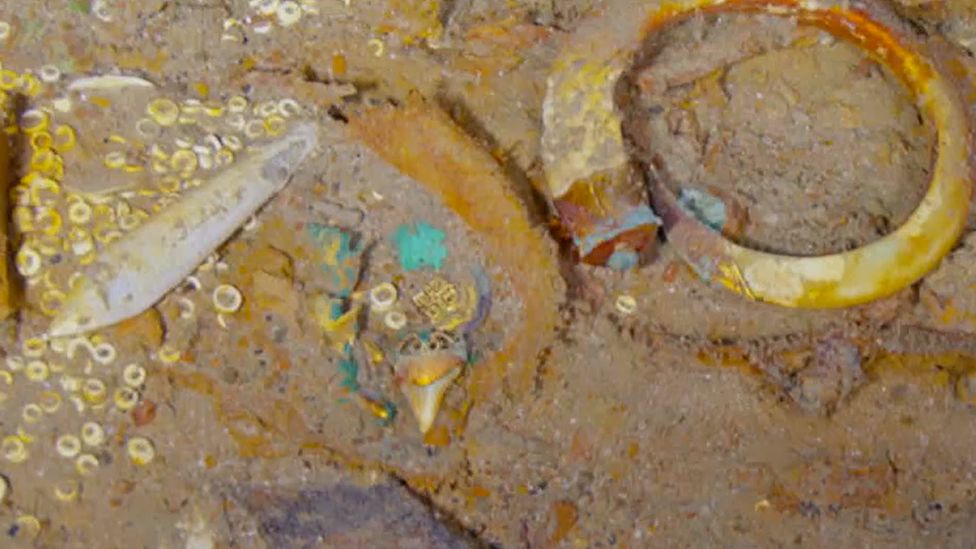 IMAGE SOURCE, MAGELLAN Image caption, The jewellery remains at the site of the wreck
IMAGE SOURCE, MAGELLAN Image caption, The jewellery remains at the site of the wreck
A necklace unseen for more than 100 years has been discovered in the wreck of the Titanic.
Guernsey-based deep-sea mapping firm Magellan captured images of gold jewellery featuring the tooth of a Megalodon, a pre-historic shark.
An image of the necklace was picked up as part of the first full-sized digital scan of the Titanic.
Richard Parkinson, Magellan's chief executive, said the discovery was "breathtaking".
The team said it was not allowed to touch the necklace due to a UK-US agreement that prevents people from removing artefacts from the wreck.
https://www.bbc.com/news/world-europe-guernsey-65721611

A necklace unseen for more than 100 years has been discovered in the wreck of the Titanic.
Guernsey-based deep-sea mapping firm Magellan captured images of gold jewellery featuring the tooth of a Megalodon, a pre-historic shark.
An image of the necklace was picked up as part of the first full-sized digital scan of the Titanic.
Richard Parkinson, Magellan's chief executive, said the discovery was "breathtaking".
The team said it was not allowed to touch the necklace due to a UK-US agreement that prevents people from removing artefacts from the wreck.
https://www.bbc.com/news/world-europe-guernsey-65721611
Mythopoeika
I am a meat popsicle
- Joined
- Sep 18, 2001
- Messages
- 51,753
- Location
- Inside a starship, watching puny humans from afar
Looks like ivory.Im more concerned about the round thing.
DrPaulLee
Justified & Ancient
- Joined
- Aug 7, 2002
- Messages
- 2,031
Titanic tourist submersible goes missing with search under way
BBC NewsA submersible craft used to take people to see the wreck of the Titanic has gone missing in the Atlantic Ocean with its crew on board, sparking a major search and rescue operation.
Tour firm OceanGate, which runs $250,000-a-seat expeditions to the wreck, said it was exploring all options to get the crew back safely.
It said government agencies and deep sea firms were helping the operation.
The Titanic sank in 1912 and lies some 3,800m (12,500ft) beneath the waves.
The missing craft is believed to be OceanGate's Titan submersible, a truck-sized sub that holds five people and usually dives with a four-day supply of oxygen.
It is not known when contact with the craft was lost.
Continues with many details of the missing sub:
https://www.bbc.co.uk/news/world-us-canada-65953872
Floyd
Antediluvian
- Joined
- Apr 2, 2019
- Messages
- 7,946
Titanic tourist submersible goes missing sparking search
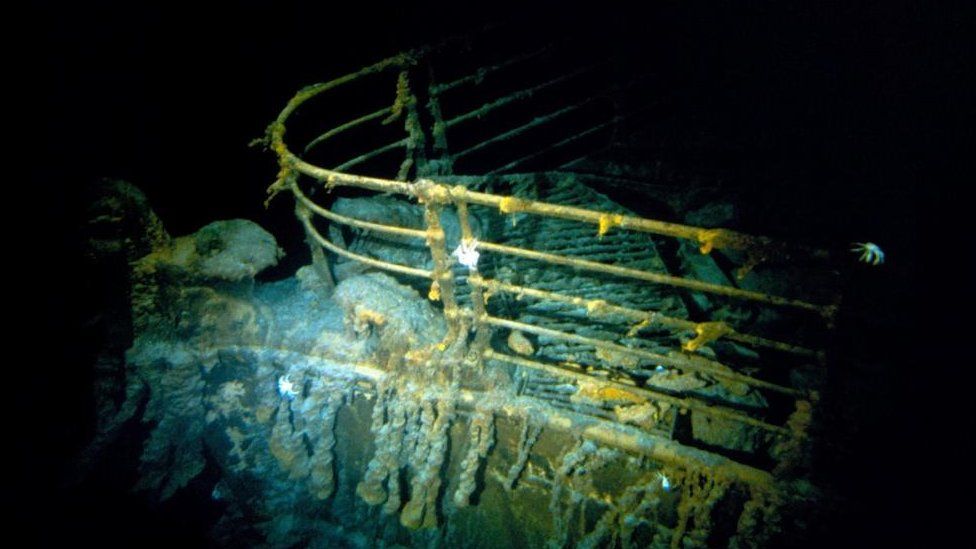
A submersible used to take people to view the wreck of the Titanic has gone missing in the Atlantic Ocean, sparking a search and rescue mission.
The Boston Coastguard told the BBC on Monday that an operation to find it was under way.
It is not clear how many people, if any, were on board at the time it went missing.
Small submersibles occasionally take paying tourists and experts to view the wreck of the Titanic.
OceanGate Expeditions, a private company that deploys submersibles for deep sea expeditions, recently posted on its social media feeds that one of its expeditions was "under way".
The company, which has not commented on the reports, charges guests $250,000 (£195,270) for a place on its 8-day expedition to see the wreck.
It bills the trip on its carbon-fibre submersible as a "chance to step outside of everyday life and discover something truly extraordinary".
The BBC has contacted the company for comment.
The Titanic sits 3,800m (12,500ft) beneath the surface at the bottom of the Atlantic. It is about 600km (370 miles) off the coast of Newfoundland, Canada.
The passenger liner, which was the largest ship of its time, hit an iceberg on its maiden voyage from Southampton to New York in 1912. Of the 2,200 passengers and crew onboard, more than 1,500 died.
The Titanic has been extensively explored since the wreck was discovered in 1985.
https://www.bbc.co.uk/news/world-us-canada-65953872

